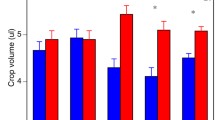Summary
In a controlled laboratory experiment, we re-examined the question of bumble bee risk-sensitivity. Harder and Real's (1987) analysis of previous work on bumble bee risk aversion suggests that risk-sensitivity in these organisms is a result of their maximizing the net rate of energy return (calculated as the average of expected per flower rates). Whether bees are risk-sensitive foragers with respect to minimizing the probability of energetic shortfall is therefore still an open question. We examined how the foraging preferences of bumble bees for nectar reward variation were affected by colony energy reserves, which we manipulated by draining or adding sucrose solution to colony honey pots. Nine workers from four confined colonies of Bombus occidentalis foraged for sucrose solution in two patches of artificial flowers. These patches yielded the same expected rate of net energy intake, but floral volumes were variable in one patch and constant in the other. Our results show that bumble bees can be both risk-averse (preferring constant flowers) and risk-prone (preferring variable flowers), depending on the status of their colony energy reserves. Diet choice in bumble bees appears to be sensitive to the “target value” a colony-level energetic requirement.
Similar content being viewed by others
References
Barnard CJ, Brown CAJ (1985) Risk-sensitive foraging in common shrews (Sorex araneus L.). Behav Ecol Sociobiol 16:161–164
Caraco T (1981) Energy budgets, risk and foraging preferences in dark-eyed juncos (Junco hyemalis). Behav Ecol Sociobiol 8:213–217
Caraco T (1982) Aspects of risk-aversion in foraging white-crowned sparrows. Anim Behav 30:719–727
Caraco T (1983) White-crowned sparrows (Zonotrichia leucophrys): foraging preferences in a risky environment. Behav Ecol Sociobiol 12:63–69
Caraco T, Chasin M (1984) Foraging preferences: response to reward skew. Anim Behav 32:76–85
Caraco T, Lima SL (1985) Foraging juncos: interaction of reward mean and variability. Anim Behav 33:216–224
Caraco T, Martindale S, Whittam TS (1980) An empirical demonstration of risk-sensitive foraging preferences. Anim Behav 28:820–830
Gillespie RG, Caraco T (1987) Risk-sensitive foraging strategies of two spider populations. Ecology 68:887–899
Harder LD (1986) Effects of nectar concentration and flower depth on flower handling efficiency of bumble bees. Oecologia (Berlin) 69:309–315
Harder LD, Real LA (1987) Why are bumble bees risk averse? Ecology 68:1104–1108
Heinrich B (1975) Thermoregulation in bumblebees II. Energetics of warm-up and free flight. J Comp Physiol 96:155–166
Houston Al, McNamara JM (1982) A sequential approach to risk-taking. Anim Behav 30:1260–1261
Moore FE, Simm PA (1986) Risk-sensitive foraging by a migratory bird (Dendroica coronata). Experientia 42:1054–1056
Oster GF, Wilson EO (1978) Caste and ecology in the social insects. Princeton Univ. Press, Princeton, NJ
Plowright RC, Laverty TM (1984) The ecology and sociobiology of bumble bees. Annu Rev Entomol 29:175–199
Possingham HP, Houston AI, McNamara JM (MS) Risk-averse foraging in bees: a comment on the model of Harder and Real.
Real LA (1981) Uncertainty and pollinator-plant interactions: the foraging behavior of bees and wasps on artificial flowers. Ecology 62:20–26
Real LA, Caraco T (1986) Risk and foraging in stochastic environments: theory and evidence. Annu Rev Ecol Syst 17:371–390
Real LA, Ott J, Silverfine E (1982) On the tradeoff between the mean and the variance in foraging: effect of spatial distribution and color preference. Ecology 63:1617–1623
SAS Institute Inc (1985) SAS User's Guide/ Statistics, Version 5 Edition. Cary, NC
Sladen FWL (1912) The humble bee: its life history and how to domesticate it. MacMillan, London
Stephens DW, Charnov EL (1982) Optimal foraging: some simple stochaistic models. Behav Ecol Sociobiol 10:251–263
Stephens DW, Paton SR (1986) How constant is the constant of risk-aversion? Anim Behav 34:1659–1667
Templeton AR, Lawlor LR (1981) The fallacy of averages in ecological optimization theory. Am Nat 117:390–393
Author information
Authors and Affiliations
Additional information
Offprint requests to: R.V. Cartar
Rights and permissions
About this article
Cite this article
Cartar, R.V., Dill, L.M. Why are bumble bees risk-sensitive foragers?. Behav Ecol Sociobiol 26, 121–127 (1990). https://doi.org/10.1007/BF00171581
Received:
Accepted:
Issue Date:
DOI: https://doi.org/10.1007/BF00171581




